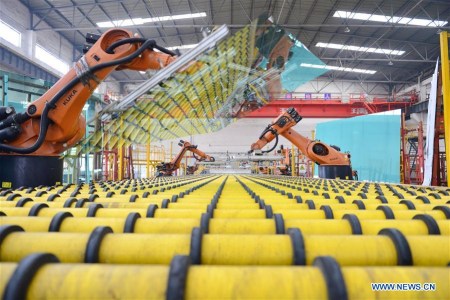
Photo taken on March 26, 2017 shows a glass production line of an enterprise in Shahe City, north China's Hebei Province. China's gross domestic product expanded 6.9 percent year on year in the first half of the year to about 38.15 trillion yuan (5.62 trillion U.S. dollars), data from the National Bureau of Statistics (NBS) showed Monday. (Xinhua/Zhu Xudong)
Economic data published by Chinese provincial-level regions for the first half year show that economic restructuring is bearing fruit and leading to stable and quality growth.
China's economy continued steady expansion in the first half of this year with GDP up 6.9 percent year on year to about 38.2 trillion yuan (5.6 trillion U.S. dollars), according to the National Bureau of Statistics (NBS).
Breaking down the national figures, provinces, autonomous regions and municipalities have published their own regional economic data.
Analysts say the data reflects new-found vitality in regional economies, unleashed by economic restructuring, which includes promoting consumption-led and innovation-driven growth, de-stocking outdated capacity, cutting corporate costs and deleveraging.
"We all know the Chinese economy has been an L-shaped growth shape. Many people ask when the downward stroke ends. Now if we look at the economic data and its connotation, the economy has entered a horizontal stroke and turned toward stable growth," said Yao Jingyuan, a research fellow at the Counsellors' Office of the State Council.
WESTERN PROVINCES IN THE LEAD
Western provinces and regions such as Tibet, Guizhou, Yunnan, Ningxia, Sichuan and Shaanxi have stayed in the top ten fastest-growing regional economies in China.
"The central and western provinces have developed well in recent years. Though they are late-movers compared with eastern counterparts, they have fared rather well economically," Yao said.
Tibet Autonomous Region topped the national chart in growth of five categories -- GDP, industrial added value, total retail sales of consumer goods, annual disposable income for urban and rural residents.
Zhou Yong, a researcher in Tibetan Academy of Social Sciences, attributes the outstanding economic figures to the social stability of Tibet, which is essential for fast economic growth.
Disposable income for people in Tibet grew by more than 10 percent in both cities and rural areas in the first half year.
"People have stable jobs and a stable source of income to spend, so retail figures of consumer goods for H1 rise by 14 percent, the fastest growth nationwide," he said.
The services industry, such as tourism, is also booming in Tibet.
Another western province Guizhou, capitalizing on big data, the information industry and tourism, has emerged as another top-performer in economic development.
Apple Inc. is expected to set up a Chinese data center, costing 1 billion dollars, in Guizhou. In H1, revenue of Internet companies in Guizhou grew by 171 percent year on year. Tourism rose by over one-third year on year as the province becomes one of China's most popular tourists destinations.
RESHAPING TRADITIONAL INDUSTRIES
Shandong Energy Zaozhuang Mining Group in east China's Shandong Province has earned revenue from a new channel other than mining.
Its revenue for H1 was 55.8 billion yuan (about 8.2 billion U.S. dollars), up 83.88 percent year on year.
"We do not depend on coal any more. The bulk of our income, more than 74 percent, comes from logistics," said Man Shengang, board chairman of the group.
China's resource-rich provinces such as Shaanxi, Inner Mongolia and Shanxi have all shown better-than-expected economic data in H1, aided by a price rebound in energy products.
Inner Mongolia Yidong Coal Group in Ordos cut its production capacity by 5 million tonnes this year, but its profits have soared.
"The price for raw coal has nearly doubled," said Wang Xiaolong, the company CFO.
From January to June, companies in Inner Mongolia cut coal production by 6.6 million tons. Though regional GDP growth slowed from the first quarter and last year, it has entered a more quality growth period, regional officials said.
In H1, China's top coal producer Shanxi Province has moved out of a sluggish period caused by coal price dives, and recovered growth. Its H1 GDP growth was 6.9 percent.
"This is the first time since the beginning of 2014 that the Shanxi economy has entered a reasonable growth margin," said Zhang Xiaodong, spokesperson with Shanxi provincial statistics bureau.
STRIVING FOR LONG-TERM GROWTH
Though the regional data shows key economic drivers are still strong enough, many warn of uncertainty.
"There are still many unstable and uncertain factors in the international market, and structural imbalances have not been completely redressed, so there are still many challenges to maintain a truly stable economy," said Wei Huaxiang, deputy secretary-general of the Shandong provincial government.
Zhang Ping, head of Guizhou statistics bureau, also said the regional government needs to find sustainable sources to drive its economic growth.
"We need to have a smooth transition from reliance on old industries to new ones that are innovation-based," he said.
Some regions, such as the Beijing-Tianjin-Hebei area, have increasingly leaned on technological innovation for growth.
Pang Jiangqian, spokesperson of Beijing Municipal Bureau of Statistics, said Beijing's high-end industries grew by 11.6 percent in H1. The capital's H1 GDP totalled 1.2 trillion yuan, up 6.8 percent year on year.
"Technological innovation has played an increasingly important role in driving the growth of Beijing," Pang said.
In July, Beijing, Tianjin and Hebei jointly published a talent promotion plan aimed to draw more skilled workers and creative minds by 2030.
"Technology and regional integration are the key to the development of the Beijing-Tianjin-Hebei region. A great many companies, talent and skilled workers have gathered here, so it has great growth potential," said He Yafei, a researcher with Renmin University.


















































